Poland
Sourced from Wikivoyage. Text is available under the CC-by-SA 3.0 license.
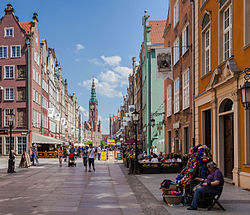
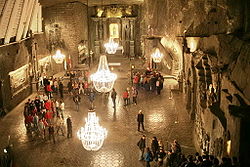
Its heritage is reflected in its architecture, museums, galleries and monuments. Its landscape is varied, and extends from the Baltic Sea coast in the north to the Tatra Mountains in the south. In between, lush primeval forests are home to fascinating species of animals including bisons in Białowieża; beautiful lakes and rivers for various watersports, the best known of which are in Warmińsko-Mazurskie; rolling hills; flat plains; and deserts. Among Poland's cities you can find the perfectly preserved Gothic old town of Toruń, Hanseatic heritage in Gdańsk and evidence of the 19th-century industrial boom in Łódź.
Today's Poland has a very homogenous society in terms of ethnicity, language and religion. The historical Republics of Poland, whose boundaries were very different from those of today, were very multi-cultural, and, for a period, Poland was known as Europe's most religiously tolerant. Poland held Europe's largest Jewish population, which was all but wiped out by the Holocaust of World War II and after the war by the anti-Semitic communist government.
Poland's western regions, including large parts of Lower Silesia, Lubuskie and Zachodniopomorskie, were parts of neighbouring Germany at different periods of time. The natural border of mountain ridges separating Poland from its southern neighbours, the Czech Republic and Slovakia, did not stop the cultural influence (and periodic warring). In the middle ages, Poland was part of a powerful Commonwealth with Lithuania that governed much of today's Belarus and Ukraine. The cultural evidence of it can be found closer to the present-day borders. Lastly, the entire eastern half of Poland used to be controlled by the Russian Empire, and there was a strong Soviet influence during the communist era, leaving behind many traces in both culture and built heritage.
Despite losing a third of its population, including a disproportionally large part of its elites, in World War II, and suffering many economic setbacks as a Soviet satellite state afterwards, Poland in many ways flourished culturally in the 20th century. Paving the way for its fellow Soviet-block states, Poland had a painful transition to democracy and capitalism in the late 1980s and 90s. In the 21st century, Poland joined the European Union and has enjoyed continuous economic growth unlike any other EU country. This has allowed it to markedly improve its infrastructure and had a profound effect on its society. Creative and enterprising, Poles continually come up with various ideas for events and festivals, and new buildings and institutions spring up almost before your eyes, so that every time you come back, you are bound to discover something new.
Regions
Poland's administrative regions are called województwa, abbreviated "woj.". The word is translated as voivodeship or province.
Southern Poland
Home to spectacular mountain ranges, the world's oldest operating salt mines, fantastic landscapes, caves, historical monuments and cities. The magnificent medieval city of Kraków is Poland's most-visited destination.
Southwestern Poland
Colorful mixture of different landscapes. One of the warmest regions in Poland with the very popular, dynamic city of Wrocław. Within this region you will find Polish, German and Czech heritage.
Northwestern Poland
A varied landscape, profusion of wildlife, bird-watcher's paradise and inland dunes. Its heritage is shaped by centuries as part of Germany.
Northern Poland
Home to Poland's attractive seaside; sandy beaches with dunes and cliffs; lakes, rivers and forests.
Eastern Poland
Very green area filled with lakes. It offers unspoiled nature and the possibility of camping in beautiful countryside. Unique primeval forests and picturesque rivers (e.g. Biebrza river) with protected bird species make the region increasingly interesting for tourists.
Cities
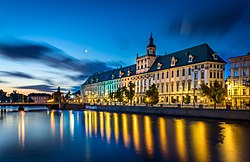
- Warsaw (Warszawa) — capital of Poland, and one of the EU's thriving new business centres; the old town, nearly completely destroyed during World War II, has been rebuilt in a style inspired by classicist paintings of Canaletto.
- — the former German city of Danzig is one of the old, beautiful European cities, rebuilt after World War II. It is a great departure point to the many sea resorts along the Baltic coast.
- Katowice — central district of the Upper Silesian Metropolis, both an important commercial hub and a centre of culture.
- — the "cultural capital" of Poland and its historical capital in the Middle Ages; its centre is filled with old churches, monuments, the largest European medieval market-place - and now with trendy pubs and art galleries. Its city centre is a UNESCO World Heritage Site.
- Lublin — the biggest city in Eastern Poland, it has a well-preserved old town with typical Polish architecture, along with unusual Renaissance elements.
- — once renowned for its textile industries, the "Polish Manchester" has the longest walking street in Europe, Piotrkowska Street, full of picturesque 19th-century architecture.
- Poznań — the merchant city, considered to be the birthplace of the Polish nation and church (along with Gniezno); presents a mixture of architecture from all epoques.
- — the most important city of Pomerania with an enormous harbour, monuments, old parks and museums.
- Wrocław — an old Silesian city with great history; built on 12 islands, it has more bridges than any other European town except Venice, Amsterdam and Hamburg.
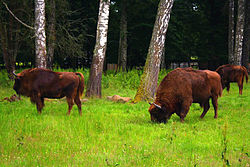
Other destinations
- — An infamous complex of German Nazi extermination and slave labour camps that became the centre of the Holocaust of Jews during World War II. UNESCO World Heritage Site.
- — a huge area of ancient woodland straddling the border with Belarus. UNESCO World Heritage Site.
- — national park protecting the Tucholskie Forests.
- — monastery in the Beskids from 1600 with Mannerist architecture and a Stations of the Cross complex. UNESCO World Heritage Site.
- — national park in the Sudety around the Śnieżka Mountain with beautiful waterfalls.
- — home to the Malbork Castle, the beautiful huge Gothic castle made of brick and the largest one in Europe. UNESCO World Heritage Site.
- — national park next to the Baltic Sea with the biggest dunes in Europe.
- — the oldest still existing enterprise worldwide, this salt mine was exploited continuously since the 13th century. A UNESCO World Heritage Site.
- — national park in Greater Poland protecting the wildlife of the Wielkopolskie Lakes.
Understand
History
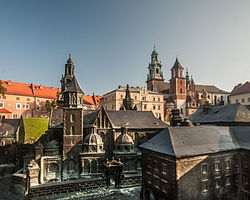
Early history

Poland was united as a country in the first half of the 10th century, and adopted Catholicism as the state religion in 966 AD. The first capital was the city of Gniezno, but a century later the capital was moved to Kraków, where it remained for half a millennium.
Poland experienced its golden age from 14th to 16th century, under the reign of king Casimir the Great, and the Jagiellonian dynasty, whose rule extended from the Baltic to the Black and Adriatic seas. In the 16th century, the Polish-Lithuanian Commonwealth was the largest country in Europe; the country attracted many immigrants, including Germans, Jews, Armenians and Dutch, because of the freedom of confession guaranteed by the state and the atmosphere of religious tolerance, which was exceptional in Europe at the time of the Holy Inquisition.
Under the rule of the Vasa dynasty, the capital was moved to Warsaw in 1596. During the 17th and the 18th centuries, the nobility increasingly asserted its independence from the monarchy; combined with several exhausting wars, this greatly weakened the Commonwealth. Responding to the need for reform, Poland was the first country in Europe (and the second in the world, after the US) to pass a constitution. The constitution of May 3, 1791 was the key reform among many progressive but belated attempts to strengthen the country during the second half of the 18th century.
Partitions and regaining independence
With the country in political disarray, various sections of Poland were occupied by its neighbors — Russia, Prussia and Austria — in three coordinated "partitions" of 1772 and 1793, and 1795. After the last partition and a failed uprising, Poland ceased to exist as a country for 123 years.However, this long period of foreign domination was met with fierce resistance. During the Napoleonic Wars, a semi-autonomous Duchy of Warsaw arose, before being erased from the map again in 1813. Further uprisings ensued, such as the 29 November uprising of 1830-1831 (mainly in Russian Poland), the 1848 Revolution (mostly in Austrian and Prussian Poland), and 22 January 1863. Throughout the occupation, Poles retained their sense of national identity, and kept fighting the subjugation of the three occupying powers.
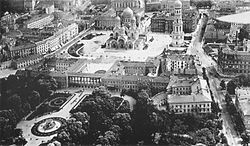
Poland returned to the map of Europe with the end of World War I, regaining its independence on November 11, 1918. In 1920-21, the newly-reborn country got into territorial disputes with Czechoslovakia and, especially, the antagonistic and newly Soviet Russia with which it fought a war. This was further complicated by a hostile Weimar Germany to the west, which strongly resented the annexation of portions of its eastern Prussian territories, and the detachment of German-speaking Danzig (contemporary Gdańsk) as a free city.
World War II
World War II in Europe began with a coordinated attack on Poland's borders by the Soviet Union from the east and Nazi Germany from the west and north. Only a few days prior to the start of the war, the Soviet Union and Germany had signed a secret pact of non-aggression, which called for the re-division of the central and eastern European nations. Germany attacked Poland on 1 September 1939 and the Soviet Union attacked Poland on 17 September 1939, effectively starting the fourth partition. These harmonised invasions caused the re-established Polish Republic to cease to exist. Hitler used the issue of Danzig (Gdańsk) as a pretext to invade Poland, much as he used the "Sudetenland Question" to conquer Czechoslovakia.Many of World War II's most infamous war crimes were committed by the Nazis and Soviets on Polish territory, with the former committing the vast majority of them. Polish civilians opposed to either side's rule were ruthlessly rounded up, tortured, and executed. Nazi Germany established concentration and extermination camps on Polish soil, where many millions of Europeans — including about 90% of Poland's long-standing Jewish population and thousands of local Romanies (Gypsies) — were murdered; of these Auschwitz is the most infamous. The Nazis murdered about three million Polish Jews and about the same number of Polish non-Jews — not only people who actively opposed the Nazi occupation, but also people randomly rounded up and shot, gassed, or taken prisoner for slave labour under intentionally life-threatening conditions in concentration camps. Part of the Nazis' strategy was to attempt to annihilate all Polish intelligentsia and potential future leadership, the better to absorb Poland into Germany, so thousands of Polish Catholic priests and intellectuals were summarily murdered. For their part, the Soviets rounded up and executed the cream of the crop of Polish leadership in the part of Poland they occupied in the Katyń Massacre of 1940. About 22,000 Polish military and political leaders, business owners, and intelligentsia were murdered in the massacre, approved by the Soviet Politburo, including by Joseph Stalin and Lavrentiy Beria.
Because of World War II, Poland lost about 20% of its population, the Polish economy was completely ruined, and nearly all major cities were destroyed. After the war Poland was forced to become a Soviet satellite country, following the Yalta and Potsdam agreements between the Western Allies and the Soviet Union. To this day these events are viewed by many Poles as an act of betrayal by the Allies. Poland's territory was significantly reduced and shifted westward to the Oder-Neisse Line at the expense of defeated Germany. The native Polish populations from the former Polish territories in the east, now annexed by the Soviet Union, were expelled by force and replaced the likewise expelled German populations in the west and in the north of the country. This resulted in the forced uprooting of over 10 million people and delayed Polish-German reconciliation. See Cold War Europe for context.
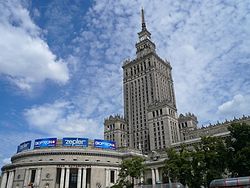
Communism (People's Republic of Poland)

After the bloody Stalinist era of 1945-1953, Poland was comparatively tolerant and progressive in comparison to other Eastern Bloc countries. But strong economic growth in the post-war period alternated with serious recessions in 1956, 1970, and 1976 which resulted in labour turmoil over dramatic inflation and shortages of goods. Ask older Poles to tell you about the impoverished Poland of the Communist era and you'll often hear stories of empty store shelves where sometimes the only thing available for purchase was vinegar. You'll hear stories about back room deals to get meat or bread, such as people trading things at the post office just to get ham for a special dinner, or religious services held secretly in basements.
A brief reprieve from this history occurred in 1978. The then-archbishop of Kraków, Karol Wojtyła, was elected as Pope of the Roman Catholic Church, taking the name John Paul II. This had a profound impact on Poland's largely Catholic population, and to this day John Paul II is widely revered in the country.
In 1980, the anti-communist trade union, "Solidarity" (Polish: Solidarność), became the major driving force in a strong opposition movement, organizing labor strikes, and demanding freedom of the press and democratic representation. The communist government responded by imposing martial law from 1981 to 1983. During this period, the country again suffered from widespread poverty, thousands of people were detained, phone calls were monitored by the government, independent organizations not aligned with the Communists were deemed illegal and members were arrested, access to roads was restricted, the borders were sealed, ordinary industries were placed under military management, and workers who failed to follow orders faced the threat of a military court.
Solidarity was the most famous of various organizations which were criminalized, and its members faced the possibility of losing their jobs and imprisonment. However, the heavy-handed repression and resulting economic disaster greatly weakened the role of the Communist Party. Solidarity was eventually legalized again, and shortly thereafter led the country to its first free elections in 1989, in which the communist government was finally removed from power. This inspired a succession of peaceful anti-communist revolutions throughout the Warsaw Pact bloc.
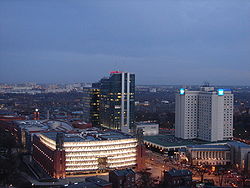
Contemporary Poland (Third Republic of Poland)
Nowadays, Poland is a democratic country with a stable and robust economy. It has been a member of NATO since 1999 and the European Union since 2004. The country's stability has been underscored by the fact that the tragic deaths of the President and a large number of political, business and civic leaders in a plane crash did not have an appreciable negative effect on the Polish currency or economic prospects. Poland has also joined the borderless Europe agreement (Schengen), with an open border to Germany, Lithuania, the Czech Republic and Slovakia, and is on track to adopt the Euro currency in a few years time. Poland's dream of rejoining Europe as an independent nation at peace and in mutual respect with its neighbors has finally been achieved. However rural Poland and the smaller towns have been in decline since the 1990s due to migrants leaving the countryside looking for better jobs in the main cities like Warsaw or Krakow.
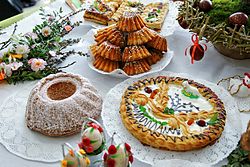
Holidays
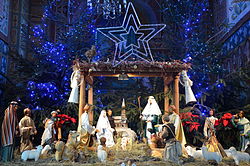
Places to eat, gas stations and pharmacies generally remain open. Some small and almost all Żabka neighbourhood convenience stores stay open, but many may have shortened opening hours. In smaller towns and villages, the local gas station can be your only resort.
Most means of public transport will run according to their Sunday schedule on public holidays, usually meaning less frequent operations. Some connections, e.g. peak bus lines, do not operate on such days entirely ("Sunday service").
If a public holiday falls on a Tuesday or Thursday, many Poles take a day off on the Monday preceding or Friday following to have a long weekend, so many companies and public administration units close on those days as well. Roads and trains may become congested on the days long weekends start or end. In tourist destinations, prices may rise and accommodation may be booked out long in advance. On the other hand, large cities often become relatively deserted.
Catholic religious holidays are widely celebrated in Poland and many provide colourful and interesting festivities and include local traditions. Most of the population, especially in smaller towns and villages, will go to church on those days and participate in them. For Christmas and Easter, it is customary to join one's family for celebratory meals and gatherings that often bring together family members from far away, so many Poles will travel to their home towns or families out of their place of residence. Having celebratory dinners in restaurants is very rare, although many hotels and restaurants would offer Christmas and Easter meals.
- New Year's Day (Nowy Rok) - 1 January is a public holiday, with celebrations taking place around midnight.
- Epiphany (Święto Trzech Króli or Objawienie Pańskie) - 6 January - is the first day of the carnival period. In many Polish cities, merry parades are organised to commemorate the biblical Wise Men.
- Easter (Wielkanoc or Niedziela Wielkanocna) is scheduled according to the moon calendar, usually in March or April. Like Christmas, it is primarily a meaningful Christian holiday. On the Saturday before Easter, churches offer special services in anticipation of the holiday, including blessing of food; children bring baskets of painted eggs and candy to be blessed. On Easter Sunday, practicing Catholics go to the morning mass, followed by a celebratory breakfast made of foods blessed the day before. On Easter Sunday, shops, malls, and restaurants are commonly closed.
- Lany Poniedziałek, or Śmigus Dyngus, is a public holiday on the Monday after Easter, and also a holiday. It's the day of an old tradition with pagan roots: groups of kids and teens wander around, looking to soak each other with water. Often groups of boys will try to catch groups of girls, and vice versa; but innocent passers-by are not exempt from the game, and are expected to play along. Water guns and water balloons are common, but children, especially outdoors and in the countryside, use buckets and have no mercy on passers-by. (Drivers - this means keep your windows wound up or you're likely to get soaked.)
- Labour Day (Święto Pracy) - 1 May is a public holiday as well. Politically inspired parades and rallies are often organized, especially in larger cities, and it is best to avoid them as opposing political factions often collide and police will usually close off the area where parades and rallies are held. Combined with May 3 (see below), this holiday provides for a surefire long weekend in most years and will see many Poles enjoy a holiday outside of their hometowns.
- Constitution Day (Święto Konstytucji Trzeciego Maja) - 3 May, celebrated in remembrance of the Constitution of 3 May 1791. The document was a highly progressive attempt at political reform, and it was Europe's first constitution (and world's second, after the US). Following the partitions, the original constitution became a highly poignant symbol of national identity and ideals.
- Pentecost (Zesłanie Ducha Świętego or Zielone Świątki) - movable feast, celebrated 7 weeks after Easter, which is always on a Sunday. It is a relatively low-key religious holiday. Since this is a Sunday, it may make little difference in some cases, but in case of establishments normally open on Sundays you may find them closed on that day. The second day (Monday) is not a public holiday and not widely celebrated in Poland.
- The Feast of Corpus Christi (Boże Ciało) is celebrated on the Thursday after Trinity Sunday, or sixty days after Easter. It is celebrated across the country; in smaller locations virtually the whole village or town becomes involved in a procession, and all traffic is stopped as the procession weaves its way through the streets.
- Assumption (Wniebowzięcie Najświętszej Marii Panny) coinciding with Day of the Polish Military (Święto Wojska Polskiego) - 15 August, commemorating the victory of the Polish Army over the invading Soviet (Red) Army in the Battle of Warsaw. The victory was attributed by the religious to the influence of the Virgin Mary. The day is marked with Catholic religious festivities and military parades.
- All Saints Day (Wszystkich Świętych) - 1 November. In the afternoon people visit graves of their relatives and light candles. After dusk cemeteries glow with thousands of lights and offer a very picturesque scene. If you have the chance, visit a cemetery to witness the holiday. Many restaurants, bars and cafés will either be closed or close earlier than usual on this holiday.
- Independence Day (Narodowe Święto Niepodległości) - 11 November, celebrated to commemorate Poland's independence in 1918, after 123 years of partitions and occupation by Austria, Prussia and Russia. Some somber official celebrations, and another slew of politically-inspired rallies are bound to be held. There are also big patriotic demonstrations and marches in larger cities, especially in Warsaw, where over 100,000 people participate in the salt marsh soil of the Independence. It is calm and many foreigners participate in it.
- Christmas Eve (Wigilia Bożego Narodzenia or simply Wigilia) - 24 December is not a public holiday, but for the Poles it is the year's most important feast. According to Catholic tradition, celebration of liturgical feasts starts in the evening of the preceding day (a vigil, hence wigilia). In Polish folklore, this translates into a special family dinner, which traditionally calls for a twelve-course meatless meal (representing the twelve apostles), which is supposed to begin in the evening, after the first star can be spotted in the night sky. On Christmas Eve most stores will close around 14:00 or 15:00 at the latest out of respect for traditions. It is also a Polish tradition to not leave anybody alone on Christmas Eve, so Polish people tend to be extremely hospitable on the evening and on many occasions will invite their lonely friends to participate in the traditional dinner. It is also acceptable to ask your friends if you could join them if you're alone. There's also a tradition of Midnight Mass on that day (Pasterka), when Christmas carols are sung.
- Christmas (Boże Narodzenie) - 25 and 26 December. On Christmas day people usually stay home and enjoy meals and meetings with families and sometimes close friends. Everything apart from essential services will be closed and public transport will be severely limited.
- New Year's Eve (Sylwester) - 31 December is not a public holiday, but many businesses will close early. Pretty much all hotels, restaurants, bars and clubs will host special balls or parties, requiring previous reservations and carrying hefty price tags. In cities, free open-air parties with live music and firework displays are organized by the authorities on central squares.
Get in
Visas
In addition to the ordinary Schengen visa waiver, citizens of South Korea, the United States of America, and Israel are permitted to spend up to 90 days in Poland without a visa, regardless of time spent in other Schengen countries. Time spent in Poland, however, does count against the time that would be granted by another Schengen state.
Regular visas are issued for travelers going to Poland for tourism and business purposes. Regular visas allow for one or multiple entries into Polish territory and stay in Poland for maximum up to 90 days and are issued for the definite period of stay. When applying for a visa, please indicate the number of days you plan to spend in Poland and a date of intended arrival. Holders of regular visas are not authorized to work.
Ukrainian citizens do not require a separate visa for transit through Poland if they hold a Schengen or UK visa.
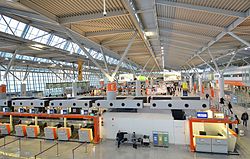
By plane
Most of Europe's major airlines fly to and from Poland. Poland's flag carrier is LOT Polish Airlines, a member of Star Alliance, operating the Miles&More frequent flyer programme with several other European Star Alliance members. Most other European legacy carriers maintain at least one connection to Poland, and there are also a number of low cost airlines that fly to Poland including WizzAir, EasyJet, Norwegian and Ryanair.

Warsaw is the only city in Poland that has two international airports - Modlin Airport (WMI), a converted former military airfield, is close to Warsaw and normally used by low-fare carriers.

- Kraków (KRK) - via Vienna, Rome, Moscow, Berlin, Helsinki, Stuttgart, Frankfurt, Munich and Warsaw
- Katowice (KTW) - via Munich, Dusseldorf, Frankfurt and Warsaw
- Gdańsk (GDN) - via Berlin, Frankfurt, Copenhagen, Oslo and Warsaw
- Poznań (POZ) - via Munich, Dusseldorf, Frankfurt, Copenhagen and Warsaw
- Wrocław (WRO) - via Frankfurt, Munich, Dusseldorf, Copenhagen and Warsaw
- Rzeszów (RZE) - via Frankfurt and Warsaw
- Łódź (LCJ) - via Copenhagen (due to proximity to Warsaw Chopin Airport, there are no flights to Warsaw from Łódź)
Smaller regional airports offering international flights include:
- Bydgoszcz (BZG) (Great Britain and Ireland with Ryanair; Lufthansa started a Frankfurt route in March 2015 with 4 flights a week)
- Szczecin (SZZ) (intercontinental connections via Warsaw)
- Lublin (LUZ) opened in late 2012, serviced by Wizz Air and Ryanair
All of the above airports are also served by low-fare point-to-point carriers, flying to European destinations. The most popular connections out of Poland's regional airports are to the UK, Ireland, Sweden and Norway, where sizable Polish minorities generate sustainable demand for air traffic. Flights are thus frequent and one can purchase a ticket at a very favorable rate.
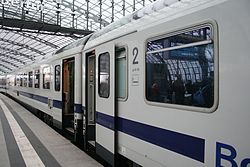
By train
Direct connections with:
- Berlin, EuroCity "Berlin-Warszawa-Express (BWE)", 4 trains per day, 5½ hr, Berlin-Gdańsk, "Strizh" train (Moscow-Berlin)
- Bratislava, night train, every day
- Budapest, night train, every day
- Kiev via Lviv, Night Train, 16 hr, Intercity+ train Przemyśl - Kiev, 2 daily, 7-9 hrs
- Vienna, Night Train "Chopin", every day, 9 hr, EuroCity "Sobieski", everyday, 6 hr, EuroCity "Polonia", every day, 8 hr
- Prague, Night Train "Chopin", EuroCity "Praha", every day, 9½ hr
- Paris, Strasbourg, Night Train "Ost-West", every day, 17 hr
- Moscow, Night Train "Polonez" (Moscow-Warsaw), 3 weekly, 18½ hr, "Strizh" train (Moscow-Berlin), 14 h
- by regional trains: Berlin-Kostrzyn (1 hr 15 min, every hour), Berlin-Szczecin (2 hr, 2 direct daily, but many with one change in Angermünde), Dresden-Wrocław (3 hr, 3 daily), Kaunas-Białystok (5 hr, 3 weekly)
By car
You can enter Poland by one of many roads linking Poland with the neighboring countries. Since Poland's entry to the Schengen Zone, checkpoints on border crossings with other EU countries have been removed.
However, the queues on the borders with Poland's non-EU neighbors, Ukraine, Belarus and Russia, are still large and in areas congested with truck traffic it can take up to several hours to pass.
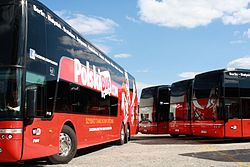
By bus
There are many international bus lines that connect major Polish cities, with most of major European ones.- Eurolines (from: A, BY, B, HR, CZ, DK, GB, EST, F, D, GR, NL, I, LV, LT, N, RUS, E, S, CH, UA), biggest European bus network.
- Ecolines
- flixbus.com Comfortable low cost bus company provides point-to-point services to and from Berlin, Vienna, Prague and Bratislava. It's the cheapest option for travellers who plan ahead.
- Simple Express
- Sindbad
- bus4us.eu website that allows you to rent a bus for an organized group of travellers. The website provides a whole range vehicles, ranging from cheaper buses to luxurious coaches.
By boat
- From Sweden: Ystad (7–9 hours, 215 zł) by Unity Line; Karlskrona (10 hours, 140-220 zł) by Stena Line; Nynäshamn (18 hours, 230-270 zł), Visby (13½ hours, 170 zł), Ystad (9½ hours, 230 zł) by Polferries
- From Germany: Rostock (~15 hr) by Finnlines
By yacht
There are along Polish coast at least at every river mouth. Bigger marinas are in Szczecin, Łeba, Hel, Gdynia and Gdańsk. Gdańsk has two yacht docks: one next to the old market square (), which is usually quickly overloaded, and one in the national sailing center next to the city center, close to the Baltic sea. The newest yacht dock is on the longest wooden pier in Sopot. Although there are many sailors in Poland, marine infrastructure still needs to be improved.
From Czech Republic
- In local, express and fast trains (not IC nor EC!), it is possible to buy a special cross-border ticket ("bilet przechodowy" in Polish) which is valid between the Czech and Polish (or vice versa) border stations and costs only CZK15 or 2 zł. You can buy it from the conductor on the train (or completely ignore it if the conductor does not emerge before you reach the other border station, which happens) and to your advantage combine it with domestic tickets of the two countries (the one you buy before departure and another one you may buy if your train stops for an amount of time in the first station after the border and you have time to quickly reach for the ticket office - or you buy the other domestic ticket at the conductor with a low surcharge).
- In the vicinity of the Czech-German-Polish three country border, you may profit from the unified fare of the ZVON transport system:
- The railway between Harrachov (Czech Republic) and Szklarska Poręba (Poland) in the Krkonoše/Karkonosze mountains () had been out of order since World War II and was reopened in 2010. In January 2013, there were 5 trains a day. The ride takes about half an hour.
- There are several trains a day between Lichkov (Czech Republic) and Międzylesie (Poland). If you arrive by the last train of the day which terminates before the border, you may try walking to the other side. From Międzylesie, you can follow the traffic directions to Brno and reach the border by following the road and passing through the villages of Smreczyna and Boboszów. Soon after you've crossed the border, make a sharp right turn at the cross road and walk the rest to Lichkov. The terrain is quite flat there. This is a little detour and takes some 13 km, but while the railway is somewhat shorter, you should not follow it because it goes through a dark forest and you would risk collision with night cargo trains, and of course the law.
- The Polish train station of Głuchołazy is served by Czech trains passing between Jeseník and Krnov and can be reached with a domestic Czech train ticket (with "Glucholazy" as the destination). You can also get a ticket starting in that station or a return ticket in advance, but you cannot buy Czech tickets in the station itself. There are no more Polish trains departing from Głuchołazy to inner Poland, only buses from the city (a 1.5-km walk from the station).
- There are very few connections a day between Bohumín (Czech Republic) and Chałupki (Poland; once called Annaberg and at the three country border of the Czech Republic, Germany and Poland), but it is easy to cross the border on foot if you miss your connection. Bohumín is a major Czech train station and Chałupki a terminal of trains to inner Poland. Between the two places, you are passing through the Czech settlement of Starý Bohumín, situated right at the border which is briefly formed by the river Odra in this place, which you cross by an old pedestrian bridge. The walk is on a completely flat terrain, almost straight, goes almost exclusively through inhabited places and is short in distance (5 km).
- The divided city of Český Těšín (Czech Republic)/Cieszyn (Poland) is a very easy spot for border crossing. If you reach one of them, you can walk to the other very comfortably and at a short distance (20 minutes from one station to another). It's the river Olše/Olza in the city centre that forms the border. The train stations in Český Těšín and Cieszyn have good connections to other destinations.
From Germany
- In the vicinity of the Czech-German-Polish three country border, you may profit from the unified fare of the ZVON transport system:
From Lithuania
- While the main railway connecting Lithuania and Poland is now crossing a piece of Belarus (which cannot be entered without a visa by most), there is fortunately a minor line left that connects the two countries directly. The border stations are Šeštokai (Lithuania) and Suwałki (Poland). There are only a few passenger connections a day and you need to change trains at the border, because of the different rail gauge used in the two countries.
- A popular alternative of crossing the border, if you are going on a longer distance, is to use the bus between Vilnius and Warsaw.
Get around
Polish road infrastructure is extensive but generally poorly maintained, and high speed motorways in place are insufficient. However, public transport is quite plentiful and inexpensive: buses and trams in cities, and charter buses and trains for long distance travel.
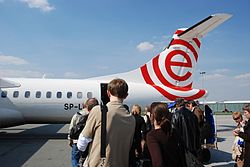
By plane
LOT Polish Airlines offers domestic flights between Warsaw Chopin Airport and the airports of Kraków, Katowice, Wrocław, Poznań, Szczecin, Gdańsk, Olsztyn (only in summer season), Zielona Góra, Rzeszów and on route between Kraków and Gdańsk. The best prices are available in booking with 60 days advance. Prices are 60-130 zł. Ryanair offers daily flights from Warsaw Chopin to Gdańsk, Wrocław and Szczecin and on route between Kraków and Gdańsk. Prices start from 9 zł. Connections from Radom to Wrocław and Gdańsk are operated by Sprint Air. There are no domestic flights to or from Warsaw Modlin, Łódź, Bydgoszcz and Lublin airports.
Every Wednesday, LOT holds a 24 hours ticket sale for return flights originating at Warsaw airport and often some other Polish airports, also including some domestic connections. The discounted flights offered are usually a few months away from the date of sale, and the number of tickets and available dates is restricted, but if you are planning ahead on visiting Poland and/or other European countries, you may find this offer attractive.
By train

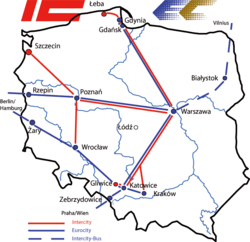
Train tickets are quite economical, but travel conditions reflect the fact that much of the infrastructure is rather old.The rule of thumb is to avoid planning any type of tight connections, as delays up to 2 hrs are not uncommon.
However, you can expect a fast, clean and modern connection on the new IC (InterCity) routes, such as Warsaw - Katowice, Warsaw - Kraków, Warsaw - Poznań and Poznań - Szczecin or RE (RegioEkspress). Consider first class tickets, because the price difference between the second and first class is not so big. The jump in comfort may be substantial but then it is also common to see trains where 2nd class carriages have been renovated and 1st class carriages are old and correspondingly low quality.
Train types
- EIP (Express Intercity Premium), EIC (ExpressInterCity), EC (EuroCity), IC (Intercity) - express trains between metro areas, and to major tourist destinations. Reservation usually required. Power points for laptops are sometimes available next to the seat. Company: PKP Intercity.
- TLK (Twoje Linie Kolejowe) - discount trains, slower but cheaper than the above. Not many routes, but very good alternative for budget travelers. Reservation obligatory for 1st and 2nd class. Use older carriages which are not always suited to high speed travel. There are also several night trains connecting southern Poland with the north. Company: PKP Intercity.
- RE (RegioEkspress) - cheaper than TLK and even higher standard, but only 3 of these type are running: Lublin - Poznań, Warsaw - Szczecin and Wrocław - Dresden. Company: Przewozy Regionalne.
- IR (InterRegio) - cheaper than TLK and RegioExpress but most routes are supporter by poor quality trains. Company: Przewozy Regionalne.
- REGIO/Osobowy - ordinary passenger train; usually slow, stops everywhere. You can also buy a weekend turystyczny ticket, or a week-long pass. Great if you are not in a hurry, but expect these to be very crowded at times. Company: Przewozy Regionalne; other.
- Podmiejski - suburban commuter train. Varying degrees of comfort and facilities. Tickets need to be bought at station ticket counters. Some companies allow you to buy a ticket on board from the train manager, in the very first compartment. A surcharge will apply.
- Narrow gauge - Poland still retains a number of local narrow-gauged railways. Some of them are oriented towards tourism and operate only in summer or on weekends, while others remain active as everyday municipal rail. See Polish narrow gauge railways.
Tickets
It's probably easiest to buy InterCity tickets on-line (see links below). You can also buy tickets on-line for Regio, RE, IR and TLK.Tickets for any route can generally be purchased at any station. For a foreigner buying tickets, this can prove to be a frustrating experience, since only cashiers at international ticket offices (in major cities) can be expected to speak multiple languages. It is recommended that you buy your train tickets at a travel agency or on-line to avoid communication difficulties and long queues.
It may be easier to buy in advance during peak seasons (e.g. end of holiday period, New Year) for trains that require reserved seating.
Tickets bought for E-IC, EC, EXpress, etc. trains are not valid for local/regional trains on the same routes. If you change trains between InterCity and Regional you have to buy a second ticket.
- Timetable search (in English, but station names of course in Polish)
- PKP information: +48 22 9436, international information +48 22 5116003.
- PKP Intercity serves express connections (tickets can be bought on-line and printed or shown to the conductor on a smart-phone, laptop or similar devices)
- Przewozy Regionalne tickets for Regio, RE and IR - only Polish version; you should provide yourself a ticket printout.
- Polrail Service offers a guide to rail travel in Poland and on-line purchase of tickets and rail passes for Polish and international trains to neighbouring countries. There's a fee of around 22 zł for every ticket.
- PolishTrains allows to search, book and buy train tickets to numerous polish and european destinations. Comparison of many train carriers allows to choose the best travel solution and purchase ticket online in the best price.
- Traffic info about all moving trains - check, if the train has a delay
If you travel in a group with the Regional, you should get a 33% discount for the 2nd, 3rd and 4th person (offer Ty i 1,2,3).
If you are a weekend traveller think about the weekend offers, which are valid from Friday 19:00 until Monday 06:00:
- for all Intercity trains (E-IC,Ex,TLK) Bilet Weekendowy (from 154 zł, reservation not included)
- for TLK Bilet Podróżnika (74zł) + Regio Bilet Plus (from 17 zł)
- for all Regional trains (REGIO, IR, RE) Bilet Turystyczny (from 79 zł)
- only for Regio trains Bilet Turystyczny (from 45 zł)
Travellers under 26 years of age and studying in Poland are entitled to 26% discount on travel fare on Intercity's TLK, EX and IC-category trains, excluding the price of seat reservation.
An early booking (7 days before departure) nay be rewarded with additional discounts.
For some IC trains you can travel with the offer Bilet Rewelacyjny - you will get an automatic discount (ca 20%) on chosen routes .
By bus
Poland has a very well developed network of private charter bus companies, which tend to be cheaper, faster, and more comfortable than travel by rail. For trips under 100 km, charter buses are far more popular than trains. However, they are more difficult to use for foreigners, because of language barrier.
There is an on-line timetable available. It available in English and includes bus and train options so you can compare: Online timetables are useful for planning, however, there are multiple carriers at each bus station and departure times for major cities and popular destinations are typically no longer than thirty minutes in-between.
Each city and town has a central bus station (formerly known as PKS), where the various bus routes pick up passengers; you can find their schedules there. Bus routes can also be recognized by signs on the front of the bus that typically state the terminating stop. This is easier if picking up a bus from a roadside stop, rather than the central depot. Tickets are usually purchased directly from the driver, but sometimes it's also possible to buy them at the station. If purchasing from the driver, simply board the bus, tell the driver your destination and he will inform you of the price. Drivers rarely speak English, so often he will print a receipt showing the amount.
Buses are also a viable choice for long-distance and international travel; however, long-distance schedules are usually more limited than for trains.
Flixbus (ex-PolskiBus) takes a more 'western' approach - you can only buy tickets through the Internet and the prices vary depending on the number of seats already sold. They have bus links between Warsaw and most of bigger Polish cities (as well as few neighboring capitals).
By car

While the road network in Poland still lags behind many of its western neighbours, in particular Germany, there has been continued significant improvement in the 2010s with the opening of many new motorway segments and refurbishments of some long-neglected thoroughfares that were used far above capacity.
In particular, travelling east-west is now generally much easier, with Berlin, Poznań and Warsaw connected with the A2 (E30), and the southern major metropoles in Lower Silesia, Silesia, Lesser Poland and Podkarpackie connected by the A4 (which continues as the E40 into Germany all the way to Cologne, and then further to Brussels and terminates in Calais in France).
Travelling north-south across the country is still not as comfortable as the major routes are still under construction or undergoing major repairs upgrades as of 2014. Most large and medium-sized cities have ring roads allowing you to bypass them even on lower-level roads, as do even smaller towns that are by the major roads. There are, however, still quite a lot of roads that are not up to snuff for the traffic they are supposed to carry and in disrepair.
By taxi
Use only those that are associated in a "corporation" (look for phone number and a logo on the side and on the top). There are no British style minicabs in Poland. Unaffiliated drivers are likely to cheat and charge you much more. Like everywhere, be especially wary of these taxis near international airports and train stations. They are called the "taxi mafia".
Because of travelers' advice like this (and word of mouth), taxis with fake phone numbers can be seen on the streets, although this seems to have decreased - possibly the police have taken notice. Fake phone numbers are easily detected by locals and cater for the unsuspecting traveler. The best advice is to ask your Polish friends or your hotel concierge for the number of the taxi company they use and call them 10–15 minutes in advance (there's no additional cost). That's why locals will only hail taxis on the street in an emergency.
You can also find phone numbers for taxis in any city on the Internet, on municipal and newspaper websites. Some taxi companies, particularly in larger towns provide for a cab to be ordered on-line or with a text message. There are also stands, where you can call for their particular taxi for free, often found at train stations.
If you negotiate the fare with the driver you risk ending up paying more than you should. Better make sure that the driver turns the meter on and sets it to the appropriate fare (taryfa):
- Taryfa 1: Daytime within city limits
- Taryfa 2: Nights, Sundays and holidays within city limits
- Taryfa 3: Daytime outside city limits
- Taryfa 4: Nights, Sundays and holidays outside city limits
The prices would vary slightly between the taxi companies and between different cities, and there is a small fixed starting fee added on top of the mileage fare.
When crossing city limits (for example, when traveling to an airport outside the city), the driver should change the tariff at the city limit.
Every taxi driver is obliged to issue a receipt when asked (at the end of the ride). You can inquire driver about a receipt (rachunek or paragon) before you get into cab, and resign if his reaction seems suspicious or if he refuses.
By bicycle
Cycling is a good method to get a good impression of the scenery in Poland. The roads can sometimes be in quite a bad state and there is usually no hard shoulder or bicycle lane. Car drivers are careless but most do not necessarily want to kill cyclists on sight which seems to be the case in some other countries.
Rainwater drainage of both city streets is usually in dreadful condition and in the country it is simply non-existent. This means that puddles are huge and common, plus pot-holes make them doubly hazardous.
Especially in the south you can find some nice places for bicycling; e.g. along the rivers Dunajec (from Zakopane to Szczawnica) or Poprad (Krynica to Stary Sącz) or Lower Silesia (Złotoryja - Swierzawa - Jawor).
Specially mapped bike routes are starting to appear and there are specialized guide books available so ask a bicycle club for help and you should be just fine. Away from roads which join major cities and large towns you should be able to find some great riding and staying at agroturystyka (room with board at a farmer's house, for example) can be a great experience.
Bike sharing systems (system roweru miejskiego) exist in all Polish major cities in which there is a growing net of bicycle segregated cycle facilities (bike lanes and bike paths are the most common). It is a self-service system in which you can rent a bike on 24/7 basis from early spring to the end of autumn, with rental fees charged according to local tariffs. First 20 minutes of a rent is usually free of charge. Charge for next 40 minutes is 1-2 zł, then every consecutive hour 3-4 zł. The major system operator in Poland is Nextbike. You should register online to get an account, make pre-payment (usually 10 zł) and then can rent bikes in all cities in which this system exists (including towns in Germany and other Central European countries).
Hitch hiking
Hitchhiking in Poland is (on average) OK. Yes, it's slower than its Western (Germany) and Eastern (Lithuania) neighbors, but your waiting times will be quite acceptable!
The best places to be picked up at are the main roads, mostly routes between Gdańsk - Warsaw - Poznań and Kraków.
Use a cardboard sign and write the desired destination city name on it.
Do not try to catch a lift where it is forbidden to stop. Look on the verge of the road and there should be a dashed line painted there, not a solid one.
As in any country, you should be careful, there are several reports of Polish hitchhiking trips gone awry, so take basic precautions and you should be as right as rain.
Talk
The official language of Poland is Polish.
Virtually all official information will usually be in Polish only. Street signs, directions, information signs, etc. are routinely only in Polish, as are schedules and announcements at train and bus stations (airports and a few major train stations seem to be an exception to this). When it comes to information signs in museums, churches, etc., signs in multiple languages are typically found only in popular tourist destinations.
The vast majority of young people and teenagers know English, usually at a decent level. Older Poles, however, especially those outside the main cities, will speak little or no English at all. However, it is possible that they speak either French, German or Russian, taught in schools as the main foreign languages until the 1990s.
Czech and Slovak, like Russian, are Slavic languages that share many similarities with Polish; it can be possible to hold a basic conversation in those languages.
A few phrases go a long way in Poland. Polish people generally love the few foreigners who learn Polish or at least try to, even if it is only a few phrases. Younger Poles will also jump at the chance to practise their English.
Do your homework and try to learn how to pronounce the names of places. Polish has a very regular pronunciation, so this should be no problem. Although there are a few sounds unknown to most English speakers, mastering every phoneme is not required to achieve intelligibility; catching the spirit is more important.
There are Polish language schools in Łódź, Kraków, Wrocław, Sopot and Warsaw.
See
Ever since Poland joined the European Union, international travellers have rapidly rediscovered the country's rich cultural heritage, stunning historic sites and just gorgeous array of landscapes. Whether you're looking for architecture, urban vibes or a taste of the past: Poland's bustling cities and towns offer something for everyone. If you'd rather get away from the crowds and enjoy nature, the country's vast natural areas provide anything from dense forests, high peaks and lush hills to beaches and lake reserves.
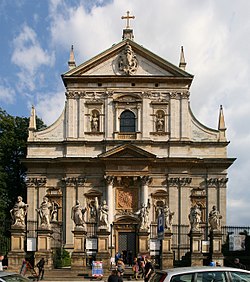 Most of the major cities boast lovely old centres and a range of splendid buildings, some of them World Heritage sites. Many old quarters were heavily damaged or even destroyed in WWII bombings, but were meticulously rebuilt after the war, using the original bricks and ornaments where possible. Although remains of the Soviet Union and even scars of the Second World War are visible in most of them, the Polish cities offer great historic sight seeing while at the same time they have become modern, lively places. The capital, Warsaw, has one of the best old centres and its many sights include the ancient city walls, palaces, churches and squares. You can follow the Royal Route to see some of the best landmarks outside the old centre. The old city of Kraków is considered the country's cultural capital, with another gorgeous historic centre, countless monumental buildings and a few excellent museums. Just 50 km from there is the humbling Auschwitz concentration camp which, due to the horrible events it represents, leaves an impression like no other World Heritage site does. The ancient Wieliczka salt mine is another great daytrip from Kraków.
Most of the major cities boast lovely old centres and a range of splendid buildings, some of them World Heritage sites. Many old quarters were heavily damaged or even destroyed in WWII bombings, but were meticulously rebuilt after the war, using the original bricks and ornaments where possible. Although remains of the Soviet Union and even scars of the Second World War are visible in most of them, the Polish cities offer great historic sight seeing while at the same time they have become modern, lively places. The capital, Warsaw, has one of the best old centres and its many sights include the ancient city walls, palaces, churches and squares. You can follow the Royal Route to see some of the best landmarks outside the old centre. The old city of Kraków is considered the country's cultural capital, with another gorgeous historic centre, countless monumental buildings and a few excellent museums. Just 50 km from there is the humbling Auschwitz concentration camp which, due to the horrible events it represents, leaves an impression like no other World Heritage site does. The ancient Wieliczka salt mine is another great daytrip from Kraków.
Once a Hanseatic League-town, the port city of Gdańsk boasts many impressive buildings from that time. Here too, a walk along the Royal Road gives a great overview of notable sights. Wrocław, the former capital of Silesia, is still less well-known but can definitely compete when it comes to amazing architecture, Centennial Hall being the prime example. Its picturesque location on the river Oder and countless bridges make this huge city a lovely place. The old town of Zamość was planned after Italian theories of the "ideal town" and named "a unique example of a Renaissance town in Central Europe" by UNESCO. The stunning medieval city of Toruń has some great and original Gothic architecture, as it is one of the few Polish cities to have escaped devastation in WWII. Other interesting cities include Poznań and Lublin.
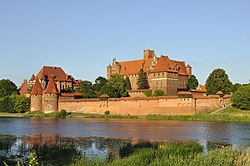 The Polish countryside is lovely and at times even gorgeous, with countless historic villages, castles, churches and other monuments. Agrotourism is therefore increasingly popular. If you have a taste for cultural heritage, the south western parts of the country offer some of the best sights, but there's great stuff in other areas too. The impressive Gothic Wawel Castle in Kraków may be one of the finest examples when it comes to Poland's castles, but most of the others are in smaller countryside towns. The large, red brick Malbork castle (in northern Poland) is perhaps the most stunning in the country, built in 1406 and today the world's biggest brick Gothic castle. The castle of Książ in Wałbrzych is one the best examples in historic Silesia, which also brought forward the now semi-ruined Chojnik castle, on a hill above the town of Sobieszów and within the Karkonoski National Park. After surviving battles and attacks for centuries, it was destroyed by lightning in 1675 and has been a popular tourist attraction since the 18th century. The picturesque Czocha Castle near Lubań originates from 1329. A bit off the beaten track are the ruins of Krzyżtopór castle, in a village near Opatów. The Wooden Churches of Southern Lesser Poland are listed by UNESCO as World Heritage, just like the Churches of Peace in Jawor and Swidnica. The Jasna Góra Monastery in Częstochowa and the beautiful, World Heritage listed Kalwaria Zebrzydowska park are famous pilgrimage destinations. The lovely Muskau Park in Łęknica, on the German border, has fabulous English gardens and is a UNESCO listing shared with Germany. Poland also shares a world heritage site with Ukraine; the Wooden tserkvas of the Carpathian region. 8 of 16 of these churches are in southeastern Poland, in the Lubelskie, Podkarpackie and Malopolskie regions.
The Polish countryside is lovely and at times even gorgeous, with countless historic villages, castles, churches and other monuments. Agrotourism is therefore increasingly popular. If you have a taste for cultural heritage, the south western parts of the country offer some of the best sights, but there's great stuff in other areas too. The impressive Gothic Wawel Castle in Kraków may be one of the finest examples when it comes to Poland's castles, but most of the others are in smaller countryside towns. The large, red brick Malbork castle (in northern Poland) is perhaps the most stunning in the country, built in 1406 and today the world's biggest brick Gothic castle. The castle of Książ in Wałbrzych is one the best examples in historic Silesia, which also brought forward the now semi-ruined Chojnik castle, on a hill above the town of Sobieszów and within the Karkonoski National Park. After surviving battles and attacks for centuries, it was destroyed by lightning in 1675 and has been a popular tourist attraction since the 18th century. The picturesque Czocha Castle near Lubań originates from 1329. A bit off the beaten track are the ruins of Krzyżtopór castle, in a village near Opatów. The Wooden Churches of Southern Lesser Poland are listed by UNESCO as World Heritage, just like the Churches of Peace in Jawor and Swidnica. The Jasna Góra Monastery in Częstochowa and the beautiful, World Heritage listed Kalwaria Zebrzydowska park are famous pilgrimage destinations. The lovely Muskau Park in Łęknica, on the German border, has fabulous English gardens and is a UNESCO listing shared with Germany. Poland also shares a world heritage site with Ukraine; the Wooden tserkvas of the Carpathian region. 8 of 16 of these churches are in southeastern Poland, in the Lubelskie, Podkarpackie and Malopolskie regions.
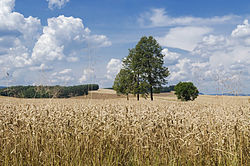
Culturally, you can visit and/or experience many churches, museums, ceramic and traditional basket-making workshops, castle ruins, rural centers and many more. A journey through the Polish countryside gives you a perfect opportunity to enjoy and absorb local knowledge about its landscape and people.
Cities

Once a Hanseatic League-town, the port city of Gdańsk boasts many impressive buildings from that time. Here too, a walk along the Royal Road gives a great overview of notable sights. Wrocław, the former capital of Silesia, is still less well-known but can definitely compete when it comes to amazing architecture, Centennial Hall being the prime example. Its picturesque location on the river Oder and countless bridges make this huge city a lovely place. The old town of Zamość was planned after Italian theories of the "ideal town" and named "a unique example of a Renaissance town in Central Europe" by UNESCO. The stunning medieval city of Toruń has some great and original Gothic architecture, as it is one of the few Polish cities to have escaped devastation in WWII. Other interesting cities include Poznań and Lublin.
Natural attractions
With 23 national parks and a number of landscape parks spread all over the country, natural attractions are never too far away. Białowieża National Park, on the Belarus border, is a World Heritage site for it comprises the last remains of the primeval forest that once covered most of Europe. It's the only place where European Bisons still live in the wild. If you're fit and up for adventure, take the dangerous Eagle's Path (Orla Perć) in the Tatra Mountains, where you'll also find Poland's highest peak. Pieniński National Park boasts the stunning Dunajec River Gorge and Karkonoski National Park is home to some fabulous water falls. The mountainous Bieszczady National Park has great hiking opportunities and lots of wild life. Wielkopolski National Park is, in contrast, very flat and covers a good part of the pretty Poznań Lakeland. The Masurian Landscape Park, in the Masurian Lake District with its 2000 lakes, is at least as beautiful. Bory Tucholskie National Park has the largest woodland in the country and has a bunch of lakes too, making it great for bird watching. The two national parks on Poland's coast are also quite popular: Wolin National Park is on an island in the north-west, Słowiński National Park holds some of the largest sand dunes in Europe.Castles & other rural monuments


Countryside
The countryside throughout Poland is lovely and relatively unspoiled. Poland has a variety of regions with beautiful landscapes and small-scale organic and traditional farms. Travelers can choose different types of activities such as bird watching, cycling or horseback riding.Culturally, you can visit and/or experience many churches, museums, ceramic and traditional basket-making workshops, castle ruins, rural centers and many more. A journey through the Polish countryside gives you a perfect opportunity to enjoy and absorb local knowledge about its landscape and people.
Do
Learn
Studying in Poland can be an incredible experience for foreigners. Foreign students can finance a B.A. education for as low as 24,000 zł and a M.A. education for as low as 20,000 zł.
There are many international schools and great universities in Poland and of them the Jagiellonian University in particular is renowned as member of the Coimbra Group and is also a core member of the Europaeum. The University of Warsaw is the top ranked public university in Poland. National Film School in Łódź is the most notable academy.
Private universities exist, and have been successful enough that several private institutions are competing with the major public universities in terms of quality. Private universities may actually be cheaper for foreign students, who are not entitled to a free education at one of Poland's public universities.
Work
TEFL courses (that's Teaching English as a Foreign Language) are run in many cities across Poland. Even if you don't have a working visa or Polish citizenship, it should be no problem for you to offer private lessons. In general students, private and in classes, are very friendly toward their teachers, inviting them for dinner or drinks, and sometimes acting quite emotional during their last lesson. Post your services on telephone poles and bus stops with an email or phone number, or use Gumtree, Poland's version of Craigslist. Gumtree Polska is useful for finding students, and accommodations.
Ekorki is good if you're looking for longer term teaching gigs. It's more formal than Gumtree, and used by serious employers. It is a little bit like Monster.com in the US.
Buy
Money
The legal tender in Poland is the Polish złoty, denoted by the synbol "zł" (ISO code:: PLN). The złoty is divided into 100 groszy (see infobox for details). In 1995, 10,000 old złoty were replaced by one new złoty. Poland is expected to adopt the euro sometime after 2019.
Private currency exchange offices (Polish: kantor) are very common, and offer euro or US dollar exchanges at rates that are usually comparable to commercial banks. Exchanges in tourist hot-spots, such as the train stations or popular tourist destinations, tend to overcharge. Avoid "Interchange" Kantor locations, easily recognized by their orange color; the rates they offer are very bad.
Cash
Polish has two types of plural numbers, which you are likely to encounter when dealing with currency. Here are the noun forms to expect:- Singular: 1 złoty, 1 grosz
- Nominative plural: 2 - 4 złote, grosze, then 22 - 24, 32 - 34, etc.
- Genitive plural: 5 - 21 złotych, groszy, then 25 - 31, 35 - 41, etc.
There is also an extensive network of cash machines or ATMs (Polish: bankomat). The exchange rate will depend on your particular bank, but usually ends up being pretty favorable, and comparable to reasonably good exchange offices, but you will probably find very high "service fees" in your bank statement when you get home.
Credit cards can be used to pay almost everywhere in the big cities. Even single bus ride tickets can be paid for by cards in major cities provided the passenger buys them in vending machines at bus stops. The exception would be small businesses and post offices where acceptance is not completely universal. Popular cards include Visa, Visa Electron, MasterCard and Maestro. AmEx and Diners' Club can be used in a few places (notably the big, business-class hotels) but are not popular and you should not rely on them for any payments. In some merchants you will be given an option to have the card bill you in Złoty or your home currency directly. In the former, your bank will convert the transaction for you (subject to the foreign exchange charges it sets) whereas in the latter, the rates set are usually worse than what your bank uses; hence choose to be charged in złoty.
Cheques were never particularly popular in Poland and they are not used nowadays. Local banks do not issue cheque books to customers and stores do not accept them.
Tipping
When you're paying for drinks or a meal in restaurants or bars and you are handed a receipt, you should give the amount you have to pay and wait for the change. If you give the money and say "thank you" it will be treated as a "keep the change" type of tip. This also goes for taxis. The average tip is around 10-15% of the price. It's polite to leave a tip, but it's not uncommon to ignore this practice.
Don't forget to tip tour guides and drivers too, but only if you are happy with the service they have provided.
Goods
It is illegal to export goods older than 55 years that are of ANY historic value. If you intend to do so you need to obtain a permit from the Ministry of Culture and National Heritage.
Shopping
Super and hypermarkets
Hypermarkets are dominated by western chains: Carrefour, Tesco, Auchan, Real. Some are open 24 hours a day, and are usually in shopping malls or suburbs.
However Poles shop very often at local small stores for bread,
meat, fresh dairy, vegetables and fruits - goods for which freshness and quality is essential.
Prices in Poland are some of the lowest in Europe.
Town markets
Many towns, and larger suburbs, hold traditional weekly markets, similar to farmers' markets popular in the West. Fresh produce, baker's goods, dairy, meat and meat products are sold, along with everything from flowers and garden plants to Chinese-made clothing and bric-a-brac. In season wild mushrooms and forest fruit can also be bought. Markets are held on Thursdays, Fridays and/or Saturdays and are a great way to enjoy the local colour. Prices are usually set though you can try a little good-natured bargaining if you buy more than a few items.
Eat
Tipping
For the most part, Polish restaurants and bars do not include gratuity in the total of the check, so your server will be pleased if you leave them a tip along with the payment. On average, you should tip 10% of the total bill. If you tip 15% or 20%, you probably should have received excellent service. Also, saying "Dziękuję" ("thank you") after paying means you do not expect any change back, so watch out if you're paying for a 10 zł coffee with a 100 zł bill. With all that said, many Poles may not leave a tip, unless service was exceptional. Poles don't usually tip bar staff.Poles take their meals following the standard continental schedule: a light breakfast in the morning (usually some sandwiches with tea/coffee), then a larger lunch (or traditionally a "dinner") at around 13:00-14:00, then a supper at around 19:00.
It is not difficult to avoid meat, with many restaurants offering at least one vegetarian dish. Most major cities have some exclusively vegetarian restaurants, especially near the city centre. Vegan options remain extremely limited, however.
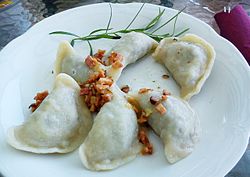
Traditional local food
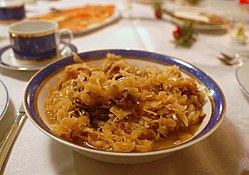
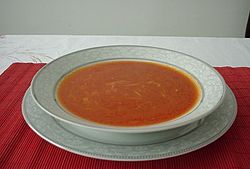

Bigos is another unique, if less well-known, Polish dish: a "hunter's stew" that includes various meats and vegetables, on a base of pickled cabbage. Bigos tends to be very thick and hearty. Similar ingredients can also be thinned out and served in the form of a cabbage soup, called kapuśniak. Some Austro-Hungarian imports have also become popular over the years, and adopted by the Polish cuisine. These include gulasz, a local version of goulash that's less spicy than the original, and sznycel po wiedeńsku, which is a traditional schnitzel, often served with potatoes and a selection of vegetables.
When it comes to food-on-the-go, foreign imports tend to dominate (such as kebab or pizza stands, and fast-food franchises). An interesting Polish twist is a zapiekanka, which is an open-faced baguette, covered with mushrooms and cheese (or other toppings of choice), and toasted until the cheese melts. Zapiekanki can be found at numerous roadside stands and bars. In some bars placki ziemniaczane (polish potato pancakes) are also available. Knysza is a polish version of hamburger, but it's much (much) bigger and it contains beef, variety of vegetables and sauces. Drożdżówka is a popular sweet version of food-on-the-go, which is a sweet yeast bread (sometimes in a form of kolach) or a pie filled with stuffing made of: poppy seed mass; vanilla, chocolate, coconut or advocaat pudding; baked apples; cocoa mass; sweet curd cheese or fruits.
Poland is also known for two unique cheeses, both made by hand in the mountain region in the south. Oscypek is the more famous: a hard, salty cheese, made of unpasteurized sheep milk, and smoked (or not). It goes very well with alcoholic beverages such as beer. The less common is bryndza, a soft cheese, also made with sheep milk (and therefore salty), with a consistency similar to spreadable cheeses. It's usually served on bread, or baked potatoes. Both cheeses are covered by the EU Protected Designation of Origin (like the French Roquefort, or the Italian Parmegiano-Reggiano).
Polish bread is sold in bakeries (piekarnia in Polish) and shops and it's a good idea to ask on what times it can be bought hot (in a bakery). Poles are often very attached to their favourite bread suppliers and don't mind getting up very early in the morning to obtain a fresh loaf. The most common bread (zwykły) is made of rye or rye and wheat flour with sourdough and is best enjoyed very fresh with butter alone or topped with a slice of ham. Many other varieties of breads and bread rolls can be bought and their names and recipes vary depending on a region. Sweet Challah bread (chałka in Polish) is sold in many bakeries.

Polish sausages (kiełbasy) are sold in grocery shops or in butcher's shops (rzeźnik). There are tens of different types of sausages; most of them can be enjoyed without any further preparation. Therefore there are sausages like biała kiełbasa (traditionally enjoyed in żurek or barszcz biały soup) which are raw and need to be boiled, fried or baked before eating. Some sausages are recommended to be fried or roasted over a bonfire (which is probably as popular as barbecuing). Different local sausages can be found in different regions of Poland (like Lisiecka in Kraków area).
Polish fish & chips (smażalnia ryb) can be found in most cities on the Baltic Sea coast. On the coast and in the Masuria you can also find extremely valued in Poland fish smokehouses (wędzarnia ryb) which sell many types of smoked local fish (mostly marine fish on the coast, freshwater fish in Masuria). Smokehouses might turn out very difficult to find, as they don't usually display advertisements and are sometimes in some remote areas. It is a good idea to do some investigation and to ask local people for directions and help with searching.
Among smoked fish offered for sale you can find: salmon (łosoś), cod (dorsz), flounder (flądra), rose fish (karmazyn), herring (śledź), halibut (halibut), pollock (mintaj), hake (morszczuk), mackerel (makrela), skipper (szprotki, szprot), trout (pstrąg), brown trout (troć), eel (węgorz), zander (sandacz), carp (karp), vendace (sielawa), tencz (lin), bream (leszcz), sturgeon (jesiotr), asp (boleń) and others.
You should be careful with smoked butterfish (maślana) as despite being very delicious it can cause diarrhea in some people and shouldn't be eaten by children and elderly people.
In the whole Poland territory you can buy some smoked fish, among which the most popular is mackerel (it is advised to buy it in a busy shop for full, fresh flavour as it deteriorates quickly; for example in a local market). Also anywhere in Poland you can buy herrings in vinegar or oil marinade. One of the Polish favourites is battered herring or other fish in a vinegar marinade.
Milk bars
If you want to eat cheaply, you should visit a milk bar (bar mleczny). A milk bar is a very basic sort of fast food restaurant that serves cheap Polish fare. Nowadays it has become harder and harder to find one. They were invented by the communist authorities of Poland in mid-1960s as a means to offer cheap meals to people working in companies that had no official canteen. Its name originates from the fact that until late 1980s the meals served there were mostly dairy-made and vegetarian (especially during the martial law period of the beginning of the 1980s, when meat was rationed). The milk bars are usually subsidized by the state. Eating there is a unique experience - it is not uncommon that you will encounter people from various social classes - students, businessmen, university professors, elderly people, sometimes even homeless, all eating side-by-side in a 1970s-like environment. Presumably, it is the quality of food at absolutely unbeatable price (veggie main courses starting from just a few złoty!) that attracts people. However, a cautionary warning needs to be issued - complete nutjobs do dine at milk bars too, so even if you're going for the food, you'll end up with dinner and a show. Curious as to what the show will entail? Well, each show varies, but most of them will leave you scratching your head and require the suspension of disbelief.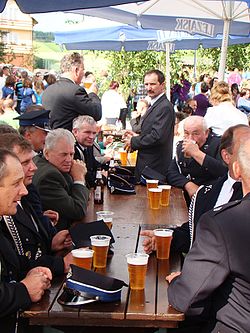
Drink
Poland is on the border of European "vodka" and "beer culture". Poles enjoy alcoholic drinks but they drink less than the European average. You can buy beer, vodka and wine. Although Poland is known as the birthplace of vodka, local beer seems to have much more appeal to many Poles. Another traditional alcoholic beverage is mead. Polish liqueurs and nalewka (alcoholic tincture) are a must.
You must be over 18 years old and be able to prove it with a valid ID to buy alcohol, and this is strictly enforced.
Beer
Poland's brewery tradition began in the Middle Ages. Today Poland is one of top beer countries in Europe.
Although not well known internationally, Poland traditionally sports some of the best pilsner-type lagers worldwide. The most common big brands include:
- Żywiec (pronounced ZHIV-y-ets)
- Tyskie (pronounced TIS-kyeh)
- Okocim (pronounced oh-KO-cheem)
- Lech (pronounced LEH)
- Warka (pronounced VAR-kah)
- Łomża (pronounced Uom-zha)
Micro-breweries and gastro-pubs are on the rise, in particular in the larger cities, and many delicatessen or supermarkets carry smaller brands, including hand-crafted beers of many types.
Pubs usually offer one or two varietes of draught beer (draft beer), usually only pilsner-type lagers. When ordering a beer, you can choose between "big one" (duże; 0.5 liter) or "small one" (małe; 0.3 liter). You can also ask for "beer with juice" (piwo z sokiem), then a barman will add a bit of sweet syrup (raspberry or ginger). The most popular snack ordered with beer is potato chips.
Vodka
Common brands are:
- Żubrówka (Zhoo-BROOF-ka) - vodka with flavors derived from Bison Grass, from eastern Poland.
- Żołądkowa Gorzka (Zho-wont-KO-va GOSH-ka) - vodka with "bitter" (gorzka) in the name, but sweet in taste. Just like Żubrówka, it's a unique Polish product and definitely a must-try.
- Wiśniówka (Vish-NIOOF-ka) - Cherry vodka (very sweet).
- Krupnik (KROOP-nik) - Honey and spices vodka, a traditional Polish-Lithuanian recipe (very sweet). During winter, many bars sell Grzany Krupnik (warm Krupnik), where hot water, cinnamon, cloves, and citrus zest or slices are added.
- Żytnia (ZHIT-nea) - rye vodka
- Wyborowa (Vi-bo-RO-va) - One of Poland's most popular rye vodkas. This is also one of the most common exported brands. Strong and pleasant.
- Luksusowa (Look-sus-OH-vah) "Luxurious" - Another popular brand, and a common export along with Wyborowa.
- Starka "Old" - A vodka traditionally aged for years in oak casks. Of Lithuanian origin
- Biała Dama (Be-AH-wa DAH-ma) is not a vodka but a name given by winos to cheap rectified spirits of dubious origin, best avoided if you like your eyesight the way it is.
- Sobieski - rye vodka, one of the most commonly chosen by Polish people.
Deluxe (more expensive) brands include Chopin and Belvedere. Most Poles consider these brands to be "export brands", and usually don't drink them.
There are also dozens of flavoured vodkas. Apart from Polish traditional flavours like: Żubrówka, Żołądkowa, Wiśniówka and Krupnik, you can easily buy some less obvious flavours like: pineapple, pear, blackcurrant, cranberry, grapefruit, apple, mint, lemon, herbs and others. The availability of different brands can vary in different regions of the country.
Wine
Poland makes wines around Zielona Góra in Lubuskie, in Małopolskie, in the Beskids and in Świętokrzyskie in central Poland. They used to be only available from the winery or at regional wine festivals, such as in Zielona Góra. But with a new law passed in 2008, this has changed and Polish wines are also available in retail stores.
As for imported wine, apart from the usual old and new world standards, there is usually a choice of decent table wines from central and eastern Europe, such as Austria, Bulgaria, Hungary, Romania, Moldova, the Balkans, and Georgia.
It winter, many Poles drink grzaniec (mulled wine), made of red wine heated with spices such as cloves, nutmeg, and ginger. A similar drink can be made with beer, although wine is the more popular method.
Mead
Mead - miód pitny is a traditional and historical alcohol drink in Poland. Mead is brewed from honey and has excellent unusual taste similar to wine. Original Polish mead contain 13-20% alcohol. Sometimes it can be very sweet. Today Poles have a strange relationship with mead. All of them have heard of it, almost none have ever tried it.
Cocktails
Poles are very keen on beer and vodka, and you'll find that cocktails are often expensive but can be found in most bars in most major cities.
One of the best known native to Poland drinks is Szarlotka made of Żubrówka vodka and apple juice.

Tea and coffee
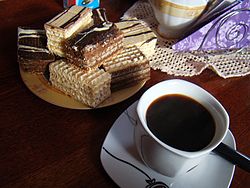
When ordering a coffee, you'll find that it is treated with respect reminiscent of Vienna, rather than, say, New York. Which is to say: you'll get a fresh cup prepared one serving at a time, with table service that assumes you'll sit down for a while to enjoy it. Mass-produced to-go coffee remains highly unpopular, although chains such as Coffee Heaven have been making inroads. Curiously, there are still only a few Starbucks shops in the whole country, which are occupied mostly by teenagers.
There are four basic types of coffee which you will be offered in Poland. In small bars, fast food or at friends home (where usually they haven't coffee makers) you can choose between instant coffee (rozpuszczalna) or Turkish coffee (kawa po turecku or kawa sypana). The second one is a very specific Polish style, not known abroad. It is simply two teaspoons of ground coffee poured with boiling water. A traditional way is to serve it in glasses. In restaurants you can additionally order "a coffee from a coffee maker" (kawa z ekspresu). It may be a very small and strong, italian-style espresso or bigger one (200 ml) americano. During order a waiter or a barman always will ask you whether you want "black one?" (czarna?; without milk) or "with milk?" (z mlekiem?).
Ordering a tea, on the other hand, will usually get you a cup or kettle of hot water, and a tea bag on the side, so that the customer can put together a tea that's as strong or as weak as they like. This is not uncommon in continental Europe, but may require some adjustment for visitors. Drinking tea with milk is not popular, traditionally Poles add a slice of lemon and sugar (herbata z cytryną), unless they drink flavored tea. Tea houses with large selection of good quality teas and a relaxing atmosphere are gaining popularity. In such places you will get rather a kettle with brewed leaf tea.
Funnily, drinking tea with milk is commonly believed in Poland to enhance women's lactation.
For the most part, a good coffee can be had for 5 - 10 zł a cup, while a cup of tea can be purchased for the same, unless you happen to order a small kettle, in which case you'll probably pay something between 15 - 30 zł.
Water
Drinking water with a meal is not a Polish tradition; having a tea or coffee afterwards is much more common. If you want water with a meal, you might need to ask for it - and you will usually get a choice of carbonated (gazowana) or still (niegazowana) bottled water, rather than a glass of tap water. As a result water isn't free, and is pretty expensive too compared to the average price of a meal (up to 4zł for one glass). Beware that sometimes even "still" bottled water, while not visibly bubbly, might still contain some carbon dioxide.
You can ask for a glass of tap water or a glass of hot water and receive it for free in most places. Therefore drinking tap water is considered to be rather weird in Poland.
Carbonated mineral waters are popular, and several kinds are available. Poland was known for its mineral water health spas (pijalnia wód) in the 19th century, and the tradition remains strong - you can find many carbonated waters that are naturally rich in minerals and salts. You can also travel to the spas such as Szczawnica or Krynica, which are still operational.
Many varieties of bottled mineral water that can be purchased originate from underground sources (since domestic spring waters are almost unavailable). Bottled mineral water usually has a neutral taste, unlike mineral water bought in water health spas which can have a very distinctive flavour. Some bottled mineral waters are regarded as very healthy due to their high content of minerals, like for example Muszynianka, Kryniczanka or all mineral waters sold in brown bottles.

Prices
Poland is still one of the cheapest countries in the European Union and its prices for food, beverages and tobacco are among the lowest.Sleep
Poland is catching up with Western Europe when it comes to availability and standards of lodging. After the Euro 2012 championships, the situation in Euro host cities in particular is now comparable to most other cities in Northern and Western Europe. Many smaller towns and locations less frequented by tourists still offer very little choice of accommodation and the existing providers make use of it rather by offering low standards than charging extortionate prices. In large cities, both in hotels and hostels, you can expect staff to have reasonable command of English, and often other foreign languages. In less frequented locations, the language barrier may be a problem.
Prices
Lodging prices are no longer the bargain they used to be several years ago; now they're comparable to standard European prices. For the bargain hunter, standard tactics apply: if hotel prices are too much, look on the Internet for private rooms, pensions, or apartments for rent, which can sometimes be found for a very reasonable price. Best deals are usually offered off-season.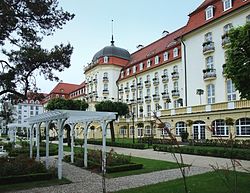
Hotels
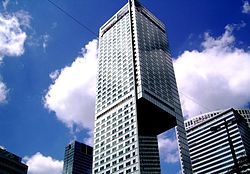
The most popular global hotel chains (Intercontinental, Marriott, Hilton, Starwood, Carlson) have some presence in Poland, but none can really boast full coverage of even the most important cities. There is a number of Best Western-affiliated hotels, but they do not cover the entire country as well. Of particular note of the motorized travellers on a budget is the presence of another French chain, Campanile.
Hostels
Hostels affiliated with the national hosteling association are often horrid options for backpackers because of imposed curfews. Additionally, Hosteling International (HI) affiliated hostels are frequently used by large school groups, which means young children may very well be screaming their heads off and running around the halls. Some private hostels are clean and welcoming, but others can be worse than HI hostels.Agritourism farms
Rural tourism has become extremely popular in Poland in the last few decades. Due to social and economic changes in the Polish countryside, many farms have changed their focus from intensive food production to tourism. Under the notion of "agritourism farm" (gospodarstwo agroturystyczne or simply agroturystyka) you may find a real farm in which hosts are real farmers working on their fields and additionally hosting tourists, letting them peek into their everyday country life. Usually, however, you will encounter countryside pensions for whom tourism is the basic source of income.Stay safe
The European unified emergency number 112 is being deployed in Poland. By now, it certainly works for all mobile-phone calls and most land-line calls.
There are also three "old" emergency numbers that are still in use for land-lines. These are: Ambulance (Pogotowie): 999, Firefighters (Straż Pożarna): 998, and Police (Policja): 997.
Municipal Guards (Straż Miejska), dial 986, is a kind of auxiliary Police force found only in large cities. They are not armed and their role is primarily to cope with parking offenses and minor cases of unsocial behavior.
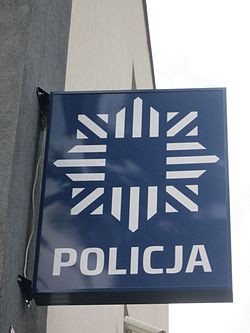
Theft
Poland is generally a safe country. In fact, you are much less likely to experience crime in places like Warsaw or Kraków than in Paris or Rome. Overall, just use common sense and be aware of what you're doing.
In cities, follow standard city travel rules: don't leave valuables in the car in plain sight; don't display money or expensive things needlessly; know where you're going; be suspicious of strangers asking for money or trying to sell you something.
Pickpockets operate, pay attention to your belongings in crowds, at stations, in crowded trains and buses, and clubs.
In any case, do not be afraid to seek help or advice from the Police (Policja) or the Municipal Guards (Straż Miejska).
One worrying trend theft at airports. Tourists have reported pickpocketing attempts at Polish airports. Always keep an eye on your belongings, especially at security checks.
Security on trains
On sleeper trains, bag robberies happen between major stations. Ask for ID from anyone who asks to take your ticket or passport and lock backpacks to the luggage racks. Keep valuables on you.
Violence
Violent behavior is relatively rare and if it occurs it is most likely alcohol-related. While pubs and clubs are generally very safe, the nearby streets may be scenes of brawls, especially late at night. Try to avoid confrontations. Women and girls are generally less likely to be confronted or harassed since the Polish code of conduct strictly prohibits any type of violence (physical or verbal) against women. By the same token, in case of a fight between mixed gender travelers, Polish men are likely to intervene on the side of the woman, regardless of the context.
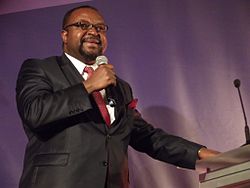
Racism
Poland is a quite homogeneous society today, except for some national minorities like Ukrainians, Belorussians, Germans and ethnic minorities like Silesians, Cashubians, Lemkos, and Jews who have been a part of Poland for years and a small wave of migrants from Africa and East Asia, including Vietnam, who have settled in the larger cities.
A lot of villages in Poland rarely have any foreign visitors, so most African or Asian people would get curious looks there - generally not because of racism, but only from pure curiosity. Of course, there are some people who don't accept foreigners, like the relatively small numbers of Neo-Nazis or football hooligans, nationalists or chauvinists. Except for the radical views of those kinds of people who you can meet almost anywhere, Poles are generally a polite and tolerant nation. As a traveller you will likely be treated in a friendly way here (see "polska gościnność" - Polish hospitality). A common Polish adage says: "gość w dom, Bóg w dom" - guest at home: God at home.
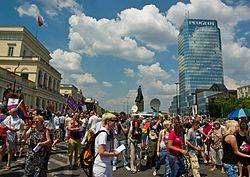
LGBT
LGBT issues remain very controversial, still very much taboo (although decreasingly so), and routinely exploited by conservative politicians (including the governing party as of 2019) and media. Polish culture also has a long tradition of chivalry and strong, traditional gender roles. In larger cosmopolitan areas, however, gays and lesbians shouldn't have a hard time fitting in, although trans visitors will immediately attract attention.Driving conditions
The Poles' aggressive driving behaviour is legendary, but the reputation quite exaggerated. While you may find drivers unreasonably impatient, speed traps have calmed down the situation since the wild days when roads were open and cars few. Another factor that hinders speeding is the often poor quality of secondary roads and simply congestion - Poles own more cars per capita than some Western European nations. Always allow some extra time for possibly unfavourable driving conditions.Stay healthy
Opinions regarding the safety of tap water vary: odds are its OK, but most residents opt to boil or filter it anyway. In Warsaw as well as in Łódź, the tap-water in the city center is usually suitable for drinking. The city authorities have even started a program to encourage school children to drink it.
Respect
Etiquette
Poles are generally old-fashioned about gender etiquette. It is customary to hold doors and chairs for women. Some men, particularly older men, may kiss a woman's hand when greeting or saying goodbye. Kissing a woman's hand is considered to be chivalrous by some, but is more and more often seen as outdated. Handshakes are acceptable; however, it is very important to remember that men should not offer their hand to a woman - a handshake is only considered polite if the woman offers her hand to the man first. For a more heartfelt greeting or goodbye, close friends of opposite sex or two women will hug and kiss three times, alternating cheeks.A fairly common practice is for people to greet each other with a dzień dobry (good day) when entering elevators, or at the very least, saying do widzenia (good bye) when exiting the elevator. Men should not wear hats indoors, in particular when entering a church (quite the opposite in case of synagogues, where men are required to wear headgear). Most restaurants, museums, and other public buildings have a cloakroom, and people are expected to leave bags and outerwear there.
It is usual to bring a gift when invited to someone's home. Flowers are always a good choice and florists' kiosks are ubiquitous. Be sure to get an odd number of flowers, as an even number is associated with funerals. Poles will often bring vodka or whisky, but this depends on the level of familiarity and the hosts' preference towards alcohol, so tread carefully. People's attitudes towards alcohol range from jolly and enthusiastic enjoyment in both practice and word to taking offence at the notion that Polish people would somehow be more prone to alcohol consumption.
It is advisable to refer to Poland (as well as to some other countries like the Czech Republic, Slovakia, or Hungary) as Central Europe, and not Eastern Europe. Although not very offensive, if used, it may reflect foreigners' ignorance and a certain disrespect of the history and clearly Latin cultural heritage of the countries from the region. Poles themselves refer to the "old" EU west of its borders as "Zachód" (West) and to the states created after the break-up of the USSR as "Wschód" (East). Geographically this is borne out by drawing a line from the tip of Norway to Greece and from the Urals to the coast of Portugal. For better or worse, Poland remains at the crossroads of Europe, right in the continent's center. In global terms, politically, culturally and historically, Poland belongs to "the West".
Another small faux pas involves confusing Polish language with Russian or German. Poles value their language highly as it was kept at a high price during a longer period of oppressive depolonisation during the partitions and WWII. For example this means not saying 'spasibo' or 'danke' for 'thank you' just because you thought it was Polish or you didn't care. If you're not sure if your 'Polish' words are indeed Polish or not it would be seen as extra polite to ask. Mentioning Polish towns and places with their former German names, when asking for directions (e.g. referring to Breslau instead of Wrocław) may cause confusion and may be regarded as offensive and disrespectful towards the Polish people.
Open display of the Communist red star and hammer and sickle symbol, the Nazi swastika and SS symbols, is prohibited by law. Make sure your clothing does not have these symbols on it, even if it's just a joke, or in the case of the swastika, a religious symbol. You can be fined for it. Performing a Nazi salute is also an offence in Poland.
Religion
The Poles may well be the most devoutly Catholic people in Europe, especially in rural areas and ever since religion in Poland became legal again in 1989. The late Pope John Paul II in particular is adored here, and the Church is held in generally high esteem. This can lead to tensions between Poland and the largely irreligious Czech Republic and Poles may feel resentment towards Czechs (and vice versa). Bear this in mind if religion is brought up in conversation with a Pole. Also, be sure to dress modestly if you enter a church, especially during services.The Holocaust
The Holocaust was the genocide of European Jewry. It was a particularly painful time for Poland. Among the victims, 3 million were Polish Jews. Additionally, at least 1.8 million non-Jewish Poles were also murdered, mostly by the Germans, and many others were enslaved. Many members of minority groups, the intelligentsia, Roman Catholic priests, and political opponents of the Nazis were among the dead. Between the census of 1939 and the census of 1945, the population of Poland had been reduced by over 30% from 35 million to 23 million.
While some other Nazi-occupied countries (such as France and Norway) were ruled by domestic collaborators and maintained their national identity through the war, Poland ceased to exist even by name, and was totally exploited by a Nazi military junta.
Using phrases such as "Polish death camps" or "Polish concentration camps" can give offence while having a conversation about history. While there is no ill-will between Poland and Germany in the 21st century, the Polish are very sensitive to conscious attempts to spread the blame for crimes committed by the erstwhile Nazi Germany. Highlighting Polish collaborators of the Nazi regime is seen as belittling the hundreds of thousands of Poles who risked their lives aiding Jews, which made the nation most represented among the Righteous Amongst the Nations honorees.
Connect
Mobile phones
There are four mobile phone operators in Poland: Plus (code 260 01), T-Mobile (260 02), Orange (260 03) and Play (260 06). About 98% of the country is covered by the standard European GSM 900/1800 MHz network, the remaining 2% are wildlife reserves or high mountains. 3G is available in almost every town. LTE networks have been deployed by Plus. Some operators have two names for their prepaid services: Plus has Plush and Simplus, T-Mobile has Heyah and Tak Tak, while Orange operates Pop and Orange Go. Domestic call rates are roughly the same across all services.Prepaid starter kits with SIM card (called starter in Polish) are widely available in reasonable prices (5-20 zł, most of which is available for calls), in most shops, supermarkets and news agents. Ask for starter and name the network you want. Accounts are valid for outgoing calls for few days, so it is good to fill them up for, lets say, 20 zł ("doładowanie" in Polish, be sure to give the value you want). Prepaid SIM cards must be registered with proof of identity. This can be done in the majority of prepaid SIM card retailers, or on the gas stations, post offices and cellular stores.
Just about every shopping centre has at least one independent cellphone shop, the guys who run them are usually knowledgeable and have a range of cheap handsets which you can use as a local/travel phone.
Polish telephone numbers
All telephone numbers in Poland are 9 digits long, and never start with 0 — although they used to do so. Sometimes numbers are written the old way, that is often only the last 7 digits are listed, in which case you need to prefix the now obligatory area code (e.g. 22 — Warsaw, 61 — Poznań, 12 — Kraków) or a 0 is included in the beginning, in which case it must be skipped. It does not matter whether you call from a land-line or a mobile.There are some special numbers, notably:
- 800 xxxxxx — toll–free call from a land-line phone and from a phone booth, but may still cost something from a mobile phone
- 801 xxxxxx — reduced fare, costs as much as a local call from a landline phone at most (but will cost more from a mobile phone)
- 70x xxxxxx — premium fare, can be very expensive — read the fine print in that advert you've got the number from. On the other hand, cheap international calls can often be made through numbers beginning with 708.
Also, texting (sending SMSes) to:
- 7xyy(y) and 9xxyy(y) — Premium SMS, x is cost in Złoty plus 23% tax, e.g. 72yy costs 2.46 zł, 70yy is 0.50 zł + 23% VAT = 0.62 zł, 910yy = 12.30 zł.
- 8xxx — is toll–free
When calling abroad, use 00, or +, and then country code.
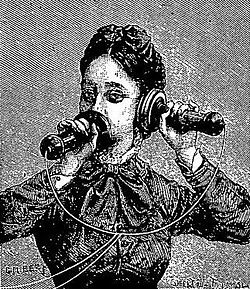
International calls
To call abroad from Poland:
- From a landline phone: 00 Country code Local number
- From a mobile phone: + Country code Local number
To call to Poland from abroad, dial 48, then the number without the leading 0, as if calling from a domestic mobile phone.
International and roaming calls are expensive. To reduce your bill you can:
- buy "phone cards" for international calls
- activate a Polish pre-paid account to make or receive calls (the cost can be as little as 20 zł)
- talk over the Internet
Skype and other free internet communicators are also massively popular in Poland.
Internet
If you're bringing a laptop, Wireless LAN Hot-Spots are available in distinct places, sometimes free, otherwise not very cheap. Best chances of finding one are at airports, railway stations, in cafés, shopping malls, libraries, central spots of some cties and universities. You can ask in your hotel, but be prepared to pay. For those who need to connect at an Internet cafe, fear not, because Poland's major cities have Internet cafes. Most coffee shops and restaurants have wi-fi available for customers - usually password-protected. Residential estates are full of wi-fi, a lot of it open, but there is anecdotal evidence of cyber crime so it is best to be careful.With your mobile phone you can use: CSD, HSCSD, GPRS or EDGE, but the cost may be unattractive. UMTS/HSPA is available in almost every big and mid-size cities. If your phone is not SIM-locked, you may consider purchasing a pre-paid SIM card designed for data access. Every mobile operator offering his own pre-paid internet offer. You may purchase Era Blueconnect Starter, iPlus Simdata, Orange Free na kartę or Play Online na kartę. Internet service from Era, Plus and Orange covers all country area with GPRS/EDGE technology. In almost every big, medium and some small size cities it's possible to receive 3G/3.5G signal.
If you have an internet-enable device that is not a phone but which has full audio capabilities (such as an iPod touch) you can of course use Skype, etc., in a wifi spot.
- T-Mobile - Blueconnect Starter - cost: 25 zł - 2GB data included - 0.30 zł/1MB
- Plus - iPlus simdata - cost: 15 zł - 1GB data included - 0.03 zł/1MB
- Orange - Orange free na kartę - cost: 20 zł - 1GB data included - 0.10 zł/1MB
- Play - Play Online na kartę - cost: 19 zł - 1GB data included - 0.03 zł/1MB Play network does not cover the entire country. You can use internet service only in cities listed on this map .
Cope
- In Poland the comma is used as a decimal point, and the space to group numbers. So, for example, 10 500,46 zł is ten thousand five hundred złoty and 46 groszy. That said, the period is increasingly often used as the decimal point, especially on price tags and bills. Occasionally a dot is also used as a grouping character.
- It is illegal to drink alcohol in public. Although often done by the locals, especially in parks, on some buses, and some of the more congested city streets, the local police take a very strict approach to enforcement of this law. Drinking alcohol in any public place puts you at risk of a small fine (from 50 to 100 zł), being scoffed at by the City Guards, and losing your booze.
- It is illegal to be drunk in public. If you are drunk and disorderly, you may be taken to a special place (izba wytrzeźwień) to sober up. If you are taken there, you will be treated as an alcoholic and won't be released until sober. And you'll have to pay 250 zł for the experience.
- Possession of drugs is illegal and a criminal offense. ANY amount.
- Since 2010, it is forbidden to smoke in bars and restaurants and generally in public buildings. It is also forbidden to smoke at or near bus stops. This rule, made to protect non-smokers, doesn't apply to smoking rooms. If you break the rule, you may have to pay 500 zł!
Toilets
The situation is not much different from other European Union countries. In large cities, particularly centres, one should have no problem finding accessible public toilets. It can become tougher in smaller towns and away from tourist destinations. While standards may vary in terms of quality and age of fittings and cleanliness, there is always a sit-down flush toilet (squat toilets, prevalent in many post-Soviet countries, are almost unheard of in Poland), a sink with running water, toilet paper, soap/hand detergent and something to dry your hands with (paper towels and/or electric dryers). In some places with extremely heavy traffic or little maintenance, supplies may run out - it is best to have a pack of tissues handy, as any prudent traveller would.Some public toilets require a small fee, 1 or 2 złoty, but more publicly accessible toilets are free of charge than in some other European countries. Relatively few toilets would have an attendant collecting the payment, which is the norm in some Western European countries like France, Portugal and Spain.
There are toilets at larger train stations and bus terminals (but not very small ones, so beware), but they are often not very clean, in poor condition and, despite all that, will generally charge fees for use. Toilets at airports are generally free, both air- and landside, and in much better condition than at train or bus stations. Toilets can be found on board all long-distance and some modern local trains, as well as on board of some long-distance buses, e.g. those operated by Polski Bus. In older train cars, toilets have often not been modernized since the cars went into use, but provide an acceptable experience (and toilet paper, soap and paper towels, except for very long routes when the train can run out of them before the staff gets a chance to restock at the end of the line).
All sit-down eating places are required to provide a toilet for their patrons, and most do so without any extra charges. While signs usually clearly indicate those are for (paying) customers only, the staff would usually make no problems if you inquired politely if you could use it without ordering anything. In some popular places, like McDonald's, you may need a key or a code to access the toilet. Ask the staff for either (in fast food outlets, the code is often at the bottom of your bill). There are also free public toilets in large shopping centres and hypermarkets, but smaller establishments (supermarkets, street-level shops) do not provide such facilities at all.
In case of larger events, organizers provide so called Toi-Toi portable toilets (from one of companies that service them). They are narrow plastic booths, usually blue, not very comfortable, often not very clean, and hardly ever with water or paper.
There are also toilets at all but the smallest gas stations. Whether they are free of charge, as well as their standards, may vary greatly, but on the road those may be your only option.
There are relatively few free-standing public toilets in cities, unlike in many other European countries. It is a better bet to look for any of the above establishments than for a free-standing public toilet. Usually you can also use a toilet in cafes, pubs, libraries or any other buildings open to the public. You should ask for permission (if anybody is there) and in many cases will be guided to the right door.
Toilets for women are marked with a circle on the door, and toilets for men are marked with a triangle. The polish word for "toilet" is toaleta (t'o-ah-let-ah), and most people would understand the word "toilet" anyway. Also, the abbreviation WC is commonly used.